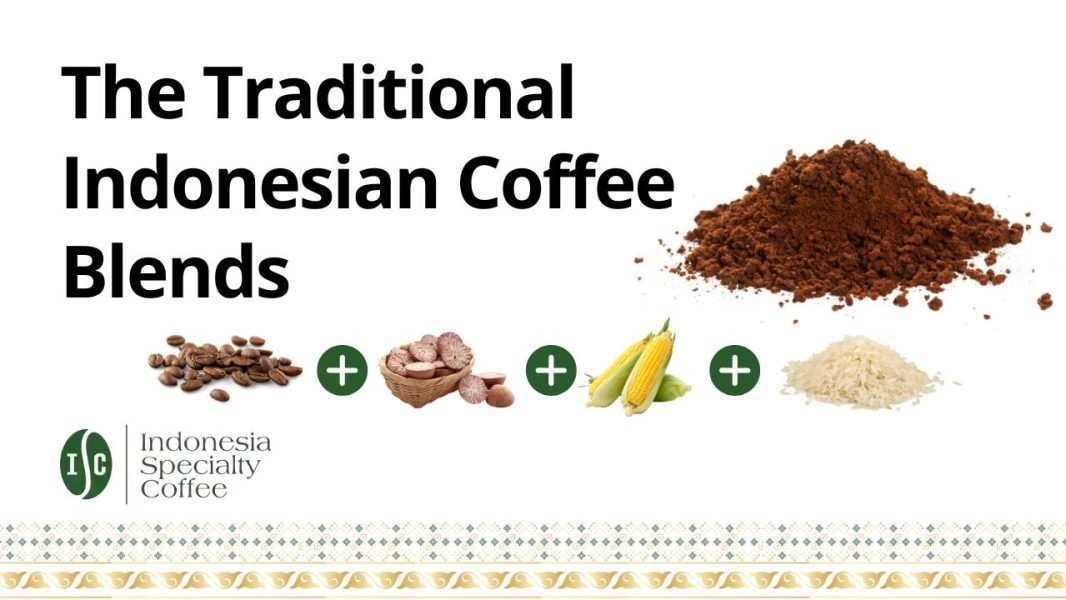Coffee Beyond the Bean
Indonesia is celebrated as one of the world’s great coffee nations. From the volcanic soils of Sumatra to the highlands of Toraja, our beans are praised internationally for their bold, earthy flavors and rich body. Yet for most Indonesians, the coffee in their cup does not come straight from these prized beans. Instead, it comes in the form of blends, mixtures of coffee with corn, rice, or even areca nut, crafted not only for affordability but also for taste and tradition.
This practice creates a quiet paradox. While international markets prize Indonesia’s Arabica and Robusta as premium exports, at home, the majority of people grow up sipping these humble blends. To many outsiders, this might look like a compromise. But within Indonesia, blends carry deep cultural meaning: they are the taste of family kitchens, roadside warungs, and late-night conversations.
This article traces the journey of Indonesian coffee blends, from the historical roots to the modern revival, to show why it is not simply a cheaper alternative, but a unique expression of the nation’s resilience and identity.
Historical Roots of Indonesia Traditional Coffee Blending
The tradition of mixing coffee with other ingredients in Indonesia dates back centuries. During the Dutch colonial period, the finest beans were often exported to Europe, leaving locals with limited access to pure coffee. To stretch what little they had, people began adding staples like corn, rice, or even cassava into their brews. What began as a survival strategy gradually became a habit, and over time, a cultural tradition.
In the years following independence, scarcity continued to shape daily consumption. Coffee was expensive for most households, yet the ritual of drinking it was too important to abandon. Blending became a way of ensuring that everyone, regardless of income, could share in the practice. In this sense, blends were not just about flavor or cost, they were about inclusion and continuity.
By the mid-20th century, blends were no longer perceived as makeshift solutions. They had become normalized as the “real taste” of coffee for millions of Indonesians. What began as necessity had transformed into heritage, carried across generations.
Ingredients and Regional Variations
Indonesian coffee blends are defined by their simplicity, but each ingredient brings a distinct character to the cup. Corn (jagung) is the most common addition, lending a gentle sweetness and body that softens coffee’s bitterness while keeping costs low. Rice (beras) serves a different purpose: it stretches the supply of coffee, lightening the flavor and making the drink more approachable. Meanwhile, areca nut (pinang) adds a nutty, earthy depth that gives the blend a more layered, complex profile.
These ingredients are not universal, each region in Indonesia has its own approach. In Java, blends tend to be lighter and smoother, with rice often included to mellow the taste. In Sumatra, where stronger, darker roasts dominate, corn or pinang is used to create a bolder cup that matches local preferences. Sulawesi, particularly Toraja, is known for experimenting with spiced or nutty touches, echoing the island’s rich culinary diversity.
Taken together, these regional differences turn a simple practice into a reflection of Indonesia’s cultural mosaic. Every blend tells a story of geography, tradition, and taste memory, a reminder that coffee here is not just a drink, but a mirror of community identity.
Affordability and Everyday Reality
Beyond taste and tradition, economics plays a decisive role in why blends remain the coffee of choice for millions of Indonesians. In today’s markets, a kilogram of traditional blend sells for around IDR 60,000, while commercial-grade Robusta averages about IDR 100,000, and premium Arabica can climb to IDR 220,000 or more. For households that drink coffee daily, these price differences are significant.
Blends make coffee accessible to all social classes. A construction worker, a market vendor, or a farmer can still afford to sit at a warung kopi with a steaming cup in hand. This accessibility reinforces coffee’s role as a social equalizer, everyone, regardless of income, can participate in the ritual.
For traders and small roasters, blending is also a survival strategy. By stretching beans with local staples, they can keep costs low while meeting the high demand for affordable coffee. Over time, this cycle has entrenched itself: consumers expect blends, traders supply them, and the tradition remains central to daily life.
Tradition in the Modern Cup
In Indonesia’s cities, a new coffee culture is rising. Specialty cafés showcase single-origin Arabica and Robusta beans, brewed through pour-overs or espresso machines, and celebrated for their complex flavor notes. To many young urban consumers, this is a way of reconnecting with the world-famous beans that their country exports.
Yet, the tradition of blends continues to hold strong. For older generations, blends are nostalgic comfort, tied to family kitchens and conversations in roadside stalls. For younger Indonesians, blends are being rediscovered as a form of heritage coffee, not inferior to specialty beans, but different, carrying the memory of resilience and community.
Today, some cafés even experiment with modernized versions of traditional blends, presenting them as part of Indonesia’s culinary identity. This signals a future where blends and specialty coffee need not compete, but instead coexist. One represents heritage, the other global prestige, together forming the full story of Indonesia’s coffee culture.

